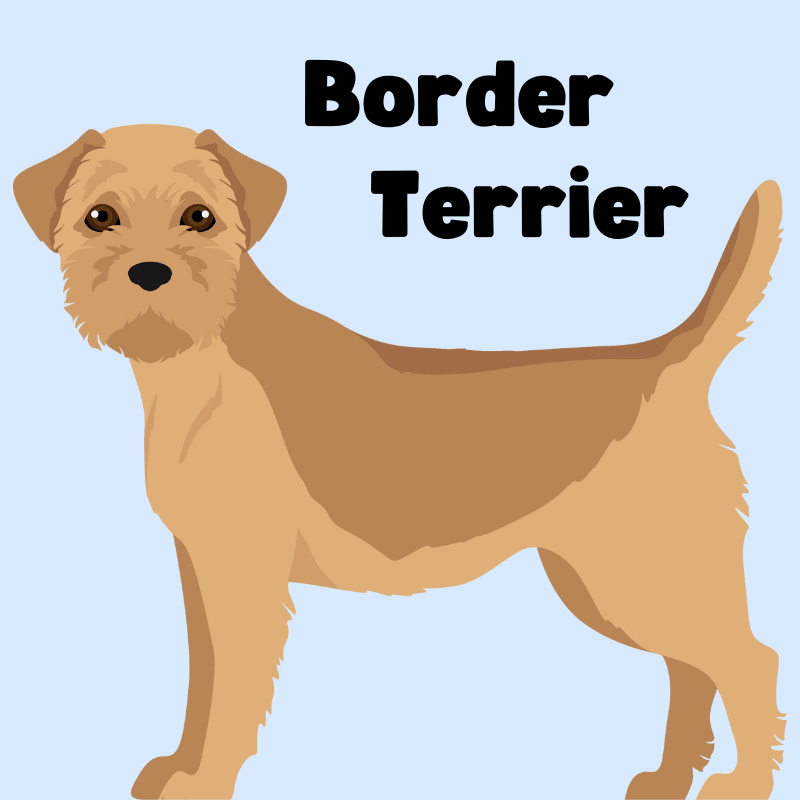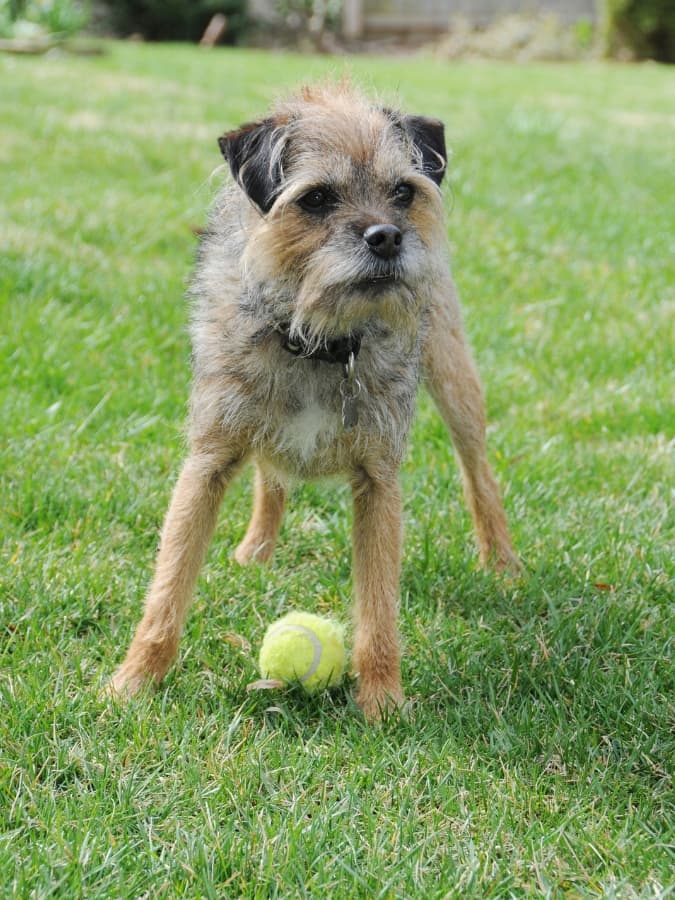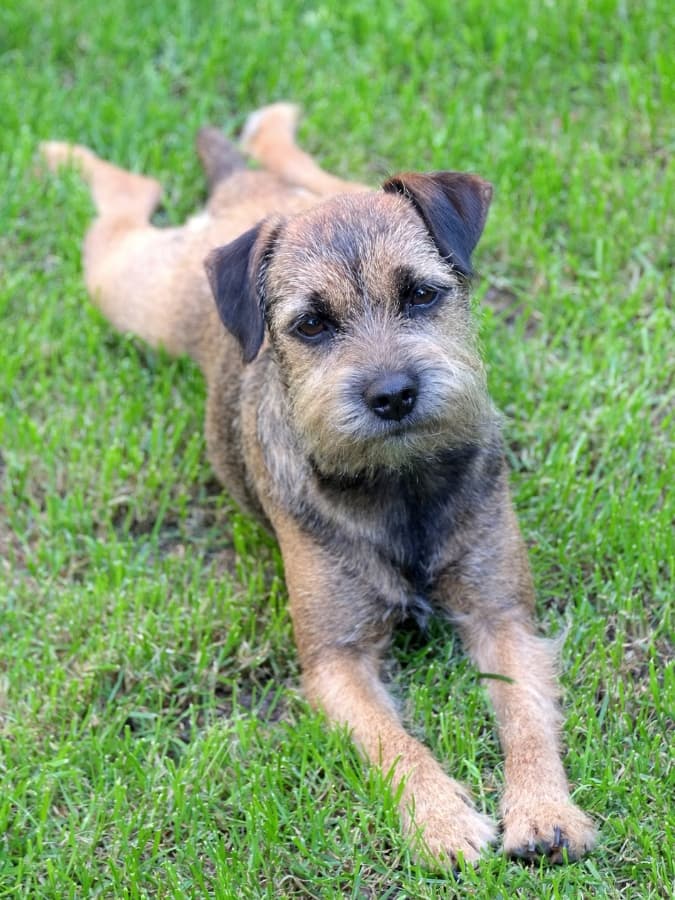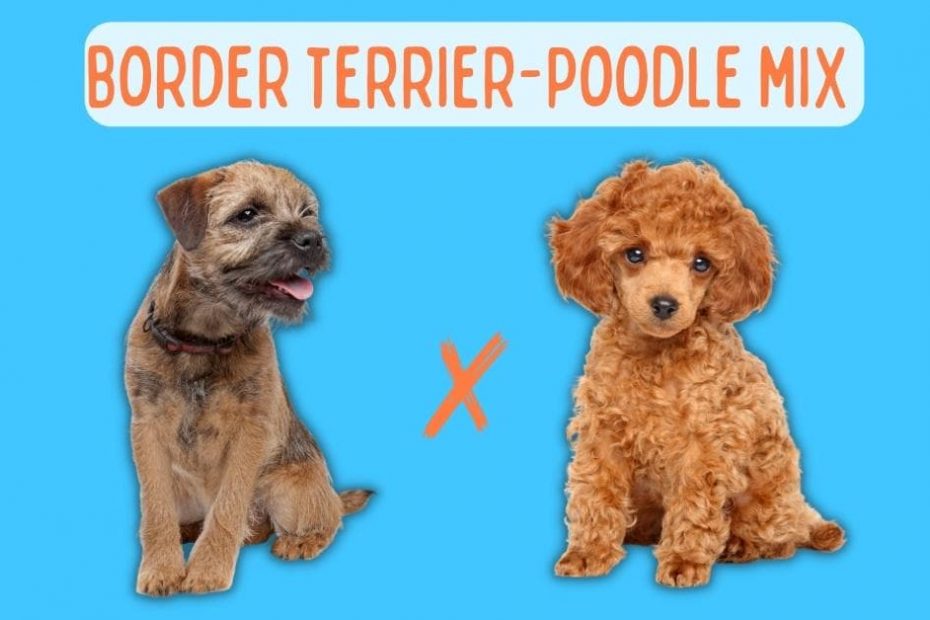If you’re a fan of fluffy, intelligent, and energetic pups, then the Border Terrier-Poodle mix is definitely the breed for you!
These playful pooches are known for their playful personalities and their ability to bring joy to any household.
Plus, with their hypoallergenic coats and high trainability, they make the perfect companion for anyone looking for a furry friend.
So why wait? Learn more about the Border Terrier-Poodle mix today and bring home the wagging tail of your dreams!
What is a Border Terrier-Poodle Mix?
The Border Terrier-Poodle mix is the unique combination of a Border Terrier and a Poodle. It is a small-sized Doodle breed. The size of the Poodle used for this cross is likely a Mini Poodle or Toy Poodle. This designer breed is also referred to as a Borderpoo or Border Terrier Poo.
History of the Parent Breeds
This section will examine the history and origins of the parent breeds, the Border Terrier and the Poodle.
Border Terrier

The Border Terrier was named after his birthplace near the hilly Scottish-English border. Here, farmers and shepherds developed swift and agile terriers to pursue and dispatch the clever sheep thief: the hill fox.
He also was named after hunting with Border Foxhounds. In early paintings, you can spot the Border bringing up the rear of the hunting party; his sturdy legs got him there just in time for the action!
The Border Terrier had a specific job: “The work of a working terrier is to follow its quarry underground, corner it, and either dispatch it or harass it so much that it bolts from the Earth.”
Naturally, therefore, the Border needed a particular build. “This required legs long enough to keep up with the Foxhounds and huntsman on horseback. But also a body small enough to dig into the fox’s lair and force it out into the open [1]AKC.”
The Border first gained his reputation as a fox hunter in Northumberland, England. One historian recounts: “there is no wall he cannot get over or wire entanglement he cannot scramble through. [So,] should the fox run to Earth, he will bolt him every time or stay the night in the Earth until the matter is settled [2]akc.org/dog-breeds/border-terrier.”
The Border is “a racy terrier of medium bone, strongly put together, suggesting endurance and agility, but rather narrow in shoulder, body, and quarter.”

The characteristic “otter” head with its keen eye, combined with a body poise which is at-the-alert,” gives a look of fearless and implacable determination characteristic of the breed [3]borderterriercanada.ca/the-breed/the-standard”. In addition, as a working Terrier, he has a naturally hard, wiry outer coat and a dense, short undercoat [4]btcoa.org/the-border-terrier-in-america.”
The Border Terrier Club of America organization was founded in 1949 to protect the standard and characteristics of the breed.
The physical and mental qualities of the Border result from generations of breeding and enable the Border to do his job with the least amount of injury to himself and with the greatest efficiency possible [5]borderterriercanada.ca/breed_info.htm.” So, if you call a Border a “purebred mutt,” it is a compliment to breeders!
What makes the Border Terrier different from other terriers? Four main traits set the Border apart: its hide, temperament, length, and legs.
The Border’s skin, hide, or pelt is thick and loose, which serves a valuable purpose. It allows him to work his way in and out of narrow openings underground and protects him from scratches and, no doubt, fox bites!
Moreover, the breed standard confirms that you should be able to grab a fistful of pelt anywhere along the back.

The length of the Border also sets him apart. His long body allows him to maneuver underground through narrow and twisted holes. Prominent ribs, bulky shoulders, or too short of legs are considered handicaps. The AKC says he should be about the length of a grown man’s forearm.
Moreover, the Border Terrier is friendlier toward other dogs. This is because they were expected to run peacefully with foxhounds. Breeders purposefully made him less dog-aggressive than other Terriers who hunted primarily independently.
Lastly, the head is the most visible difference. The Border standard calls for a head shaped like an otter, described as “moderately broad and flat in skull with plenty of width between the eyes and ears—a slight, moderately broad curve at the stop rather than a pronounced indentation with slightly full cheeks.”
Poodle

The term “Poodle” comes from the German word “pudel” or “pudelin,” which means “to splash in the water [6]akc.org/expert-advice/lifestyle/10-facts-about-poodles”. This was because hunters initially bred Poodles to retrieve waterfowl.
Even though Poodles remain excellent hunters, today, they have become popular as companion dogs worldwide.
They are brilliant and easy to train, which makes them great pets for people who want a dog that can learn tricks and perform well in obedience competitions. Plus, they are known for being hypoallergenic, which is a huge plus for people who are allergic to dogs but still want to own one.
But the biggest reason for their popularity is their unique appearance. Poodles have a reputation for being fashionable and sophisticated, and their fluffy, curly coats can be styled in various cuts, from the classic “Poodle clip” to more modern, trendy styles. And let’s not forget about those adorable little pom-poms on their tails!
Overall, I think Poodles are just an all-around lovable breed, and it’s no surprise that they are so popular in modern culture.
Interesting fact: The Poodle cut was meant for function, not fashion! Less hair made the Poodle a more efficient swimmer but more vulnerable to the cold. To find a happy compromise, Poodle owners left puffs of hair on the head, upper torso, and ankles for warmth [7]akc.org/expert-advice/lifestyle/10-facts-about-poodles.
Appearance
The Border Terrier-Poodle mix has a fluffy, round face, otter-like eyes, and a slightly prolonged nose. The body has modest proportions, yet a somewhat longer body and legs.
The breed may have a multi-colored coat. The coat would range from short to long, wiry to wavy. Their stance is a playful balance of spirit and pride.
Coat Type
Mix a Poodle and a Border Terrier, and the result likely ranges from short to long, wavy and wiry. In contrast, the Poodle has wavy to lush curly hair. Regardless, the breed is low shed.
Coat Colors
The Border Terrier-Poodle Mix comes in a variety of colors and color combinations. Usually, the ears are the darkest shade, the body is a medium shade, and parts of the face and feet are lighter toned.
The following is a list of potential colors that a Border Terrier-Poodle mix could be:
- Apricot
- Black
- Blue
- Brown
- Cafe Au Lait
- Cream
- Grey
- Red
- Silver
- Silver-beige
- White
- Blue & Tan
- Grizzle & Tan
- Red
- Wheaten
The parents ultimately determine the color. Consult the breeder about all possible color outcomes.
Grooming
The breed’s particular coat determines the level of grooming required. For example, the Border’s coat is an easy keeper, with the occasional stripping. However, if the coat is more like the Poodle, frequent brushing and clipping are needed to prevent matting.
Size
The Border Terrier-Poodle mix can range from small to medium-size, depending on the size of the Poodle used for the litter.
Height
Toy: 10.2 – 13.5 in
Mini: 11 – 15.5
Standard: 14.5 – 20 in
*Includes male and female averages of both breeds
Weight
Toy: 7.5 – 13 lbs
Mini: 10.5 – 15.5
Standard: 25.5 – 43 lbs
*Includes male and female averages of both breeds
Traits & Characteristics

Temperament & Personality
The Border Terrier-Poodle mix is generally easily trained, good with children, and friendly towards other dogs. However, the breed needs regular exercise and high levels of stimulation to stay calm and adaptable.
In addition, grooming is moderate depending on hair or fur type. Nevertheless, the breed would be a low-shed dog.
They would not last long isolated in the backyard or cooped up in a crate for long periods. But, above all, if the Border Terrier Poodle had a love language, it is quality time.
Common Health Issues
The Border Terrier-Poodle Mix is a generally healthy breed. However, it is critical to be aware of possible health issues.
Hip Dysplasia: Hip Dysplasia means a loose hip joint. This condition can cause inflammation and pain and is most likely to appear in the dog’s later years.
Progressive Retinal Atrophy: The eye muscles slowly deteriorate, weakening the dog’s vision—also a possible condition in the dog’s later years.
Juvenile Cataracts: an irregular eye blockage that disturbs vision. It is considered hereditary (inherited as a genetic disease from one or both parents). The likelihood of cataracts increases with age. In most instances, a vet can remove the cataract and restore sight.
Seizures: a neurological condition or lapse in brain activity that causes convulsions or involuntary muscle movement. Idiopathic epilepsy, the most common cause of seizures in dogs, is an inherited disorder, but its exact cause is unknown [8]vcahospitals.com/know-your-pet/seizures-general-for-dogs.
Heart Problems: heart disease has no singular cause. It could result from aging, obesity, breed, and nutrition. Heart valve problems are the most common issue and typically affect small breed dogs five years or older [9]cvcavets.com/canine-heart-diseases.
Allergies: reactions to foreign substances by the body’s immune system. There are many different allergies: skin, food, and environmental. In addition, the symptoms of different types of allergies can overlap [10]akc.org/expert-advice/health/dog-allergies-symptoms-treatment.
Heat Warning: It is crucial to keep the hair short in hot weather. The breed’s Border parent is less tolerant of hot weather, so outdoor exercise should be kept to a minimum when the temperature gets above 85 degrees Fahrenheit [11]akc.org/dog-breeds/border-terrier.
Lifespan
The lifespan of a Border Terrier-Poodle cross will likely range between 10-18 years. This estimate is based on the average life expectancy of both parent breeds.
Final Thoughts
The Border Terrier-Poodle mix is an affectionate companion. Any owner who desires a dog who can think for himself will adore its personality. However, this blend is also intelligent with an independent streak.
Moreover, their behavior is generally calm with regular exercise and quality time. Above all, they thrive when they feel part of a family! And while its hunting instinct may kick in when a small rodent scurries by, they are easily trained.
Check out these articles
If you fell in love with the Border Terrier-Poodle mix, then you might also be interested in checking out these other Terrier-Poodle mixes:
- Foodle [Fox Terrier x Poodle]
- Airedoodle [Airedale x Poodle]
- Whoodle [Soft Coated Wheaten Terrier x Poodle]
- Norfipoo [Norfolk Terrier x Poodle]
- American Hairless Terrier x Poodle

References

